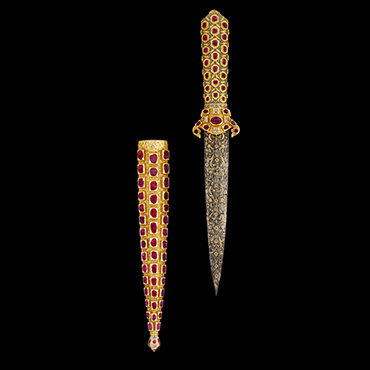Imperial death and glory
Jewelers at the Ottoman court had access to the finest materials and produced a small group of exceptionally fine jeweled ceremonial daggers, of which this is a spectacular example. Some of these were diplomatic gifts to important European rulers, clearly intended to impress their recipients. An almost identical dagger to this one, now housed in the Museum of Applied Arts in Vienna, was likely presented to a Habsburg emperor. Here, the jade hilt is set with rubies and gold, with a matching gold sheath decorated with rubies on the front and engraved on the back. Even the steel blade is exquisitely carved and inlaid with gold in elegant leaf designs. Despite being an object of extraordinary artistry, this dagger is also a highly effective weapon, with a blade forged from the finest steel.
The quality and detail of this dagger and its sheath strongly suggest they were crafted by Mehmed bin Imad, the court jeweler to Sultan Murad III (r. AH 981–1003/1574–95 CE) and Sultan Ahmed I (r. AH 1011–26/1603–17 CE). Mehmed was entrusted with some of the most high-profile commissions of the time, including the binding for a poetic work written by Murad III himself, a key for the Ka‘bah, and a chest for relics of the Prophet Muhammad (pbuh). He is also believed to have produced a Qur’an binding and a crown for the Imperial treasury, among other notable pieces. Several sword fittings, including embellishments from the early Islamic period, are also credited to him. Given his expertise and reputation, he would have been the natural choice to create a dagger of this caliber, worthy of a sultan.
Imperial death and glory
Dagger with sheath
Türkiye, late 10th century AH/16th century CE
Steel, jade, gold, niello, ruby, diamond, together l. 38.5 cm
Furusiyya Art Foundation, R-421

